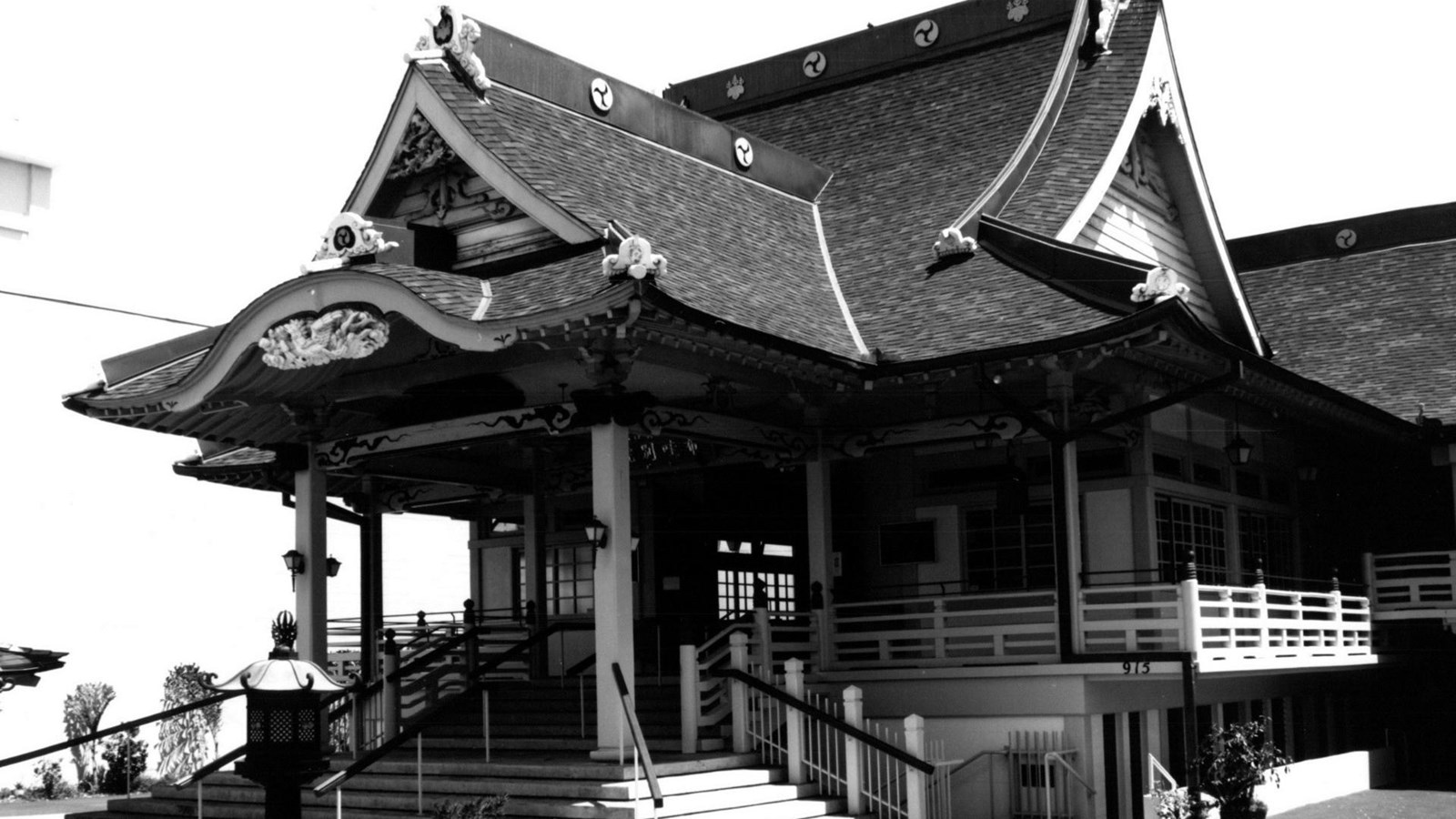Last updated: December 16, 2024
Place
Hawaii Shingon Mission

Historic Hawaii Foundation
This article is part of a series about Religion on the World War II Home Front.
Hawaii Shingon Mission (also known as Shingon Shu Hawaii) is a historic Buddhist temple in Honolulu, Hawaii. It features distinctive Japanese architectural elements, including a steep roof with elaborate decorative carvings. During World War II, prejudice against Hawaiians of Japanese descent—especially Buddhists—turned many temples and shrines into targets. Hawaii Shingon Mission survived, but vandals attacked other nearby sites, even burning some to the ground.
Buddhism in Hawaii
About 35% of Hawaii’s population in 1941 had Japanese ancestry. Many Nikkei, as this group was known, were the descendants of immigrants who had come to work on the islands’ sugar plantations. About 85% of Nikkei in Hawaii were Buddhists. Religious practice connected them to their origins. Priests conducted most services in Japanese and maintained strong ties to sect leaders in Japan. Temples and shrines functioned as community hubs and gathering spaces. They provided a source of cohesion and stability for migrants living and working far from home.
The US government and many white Americans, however, viewed Buddhist or Shinto Nikkei with distrust and suspicion. According to the scholar Duncan Ryūken Williams, “religious difference acted as a multiplier of suspiciousness” for Nikkei who were already treated as racially “other.” Many non-Japanese residents of Hawaii believed that Buddhism was tied to Japanese nationalism and that Buddhists could not be loyal Americans. As tensions between the US and Japan rose in the lead-up to World War II, the US government compiled a list of suspected “subversives” that included many Buddhist priests.
World War II
The Japanese attack on Pearl Harbor on December 7, 1941, sent seismic waves through American society and propelled the nation into World War II. Its local effects, while less well known, were also dramatic. Immediately after the attacks, military authorities detained about 200 Buddhist priests and imprisoned many of them at a camp called Sand Island. When the mother of Private Torao Migita, a Japanese American soldier killed at Pearl Harbor, looked for a Buddhist priest to perform her son’s funeral, she found that almost all of them had already been arrested.
Most other Nikkei in Hawaii avoided the defining experience of World War II for mainland Japanese Americans: incarceration. While class and ethnic prejudices shaped Hawaiian society, the more extreme racial discrimination apparent in the mainland United States was absent. Military authorities considered removing Hawaiians of Japanese descent, but ultimately calculated that most of them were probably loyal and that the logistical and economic costs of removing 160,000 people would be too high. However, the US did incarcerate about 2000 civilians of Japanese descent at Sand Island and later at Hono'uli'uli Internment Camp. Most were American citizens.
Martial Law
Nikkei, especially Buddhists, faced suspicion, prejudice, and even violence from many of their neighbors. Hours after the attacks, the state declared martial law. It remained in force until late 1944. The powers granted by martial law allowed the US military to tightly control Hawaiians’ activities with curfews and work restrictions. The authorities regulated worship as well. They controlled when some temples were allowed to be open and confiscated property from others. Nikkei Christians did not face the same kinds of prejudice. Most churches remained open, and the authorities did not arrest Christian ministers at nearly the same rate as Buddhist priests.
Meanwhile, some Hawaii residents expressed their prejudice against Nikkei Buddhists through vandalism and arson of temples and shrines. One Japanese American woman recalled weeping as she rescued precious items from her temple’s altar after vandals set it on fire. She stored them at the nearby Hawaii Shingon Mission.
While the Mission managed to survive the tumult of war, many other temples and shrines did not. Nevertheless, though damaged and changed, a thriving Buddhist culture persisted in Hawaii during and after World War II. Hawaii Shingon Mission was added to the National Register of Historic Places on April 26, 2002.
Bibliography
“Hawaii Shingon Mission.” National Register of Historic Places Nomination Form. Washington, DC: US Department of the Interior, National Park Service, 2002. https://catalog.archives.gov/id/63815900.
Hinnershitz, Stephanie. “Japanese Americans and the Wartime Experience in Hawaii.” National World War II Museum, Oct. 15, 2011. https://www.nationalww2museum.org/war/articles/japanese-americans-wartime-experience-hawaii.
Nishigaya, Linda and Ernest Oshiro. “Reviving the Lotus: Japanese Buddhism and World War II Internment.” Social Process in Hawai'i 45 (2014): 173-198. https://dspace.lib.hawaii.edu/bitstream/10790/4429/nishigaya.l-2014-0001_ocr.pdf.
Personal Justice Denied: Report of the Commission on Wartime Relocation and Internment of Civilians. Washington, DC: US Government Publishing Office, 1982. https://www.archives.gov/research/japanese-americans/justice-denied.
Scheiber, Harry N. and Jane L. Scheiber. Bayonets in Paradise: Martial Law in Hawai’i during World War II. Honolulu, HI: University of Hawai’i Press, 2016.
Williams, Duncan Ryūken. American Sutra: A Story of Faith and Freedom in the Second World War. Cambridge, MA: The Belknap Press of Harvard University Press, 2019.
Article by Ella Wagner, Cultural Resources Office of Interpretation and Education.
